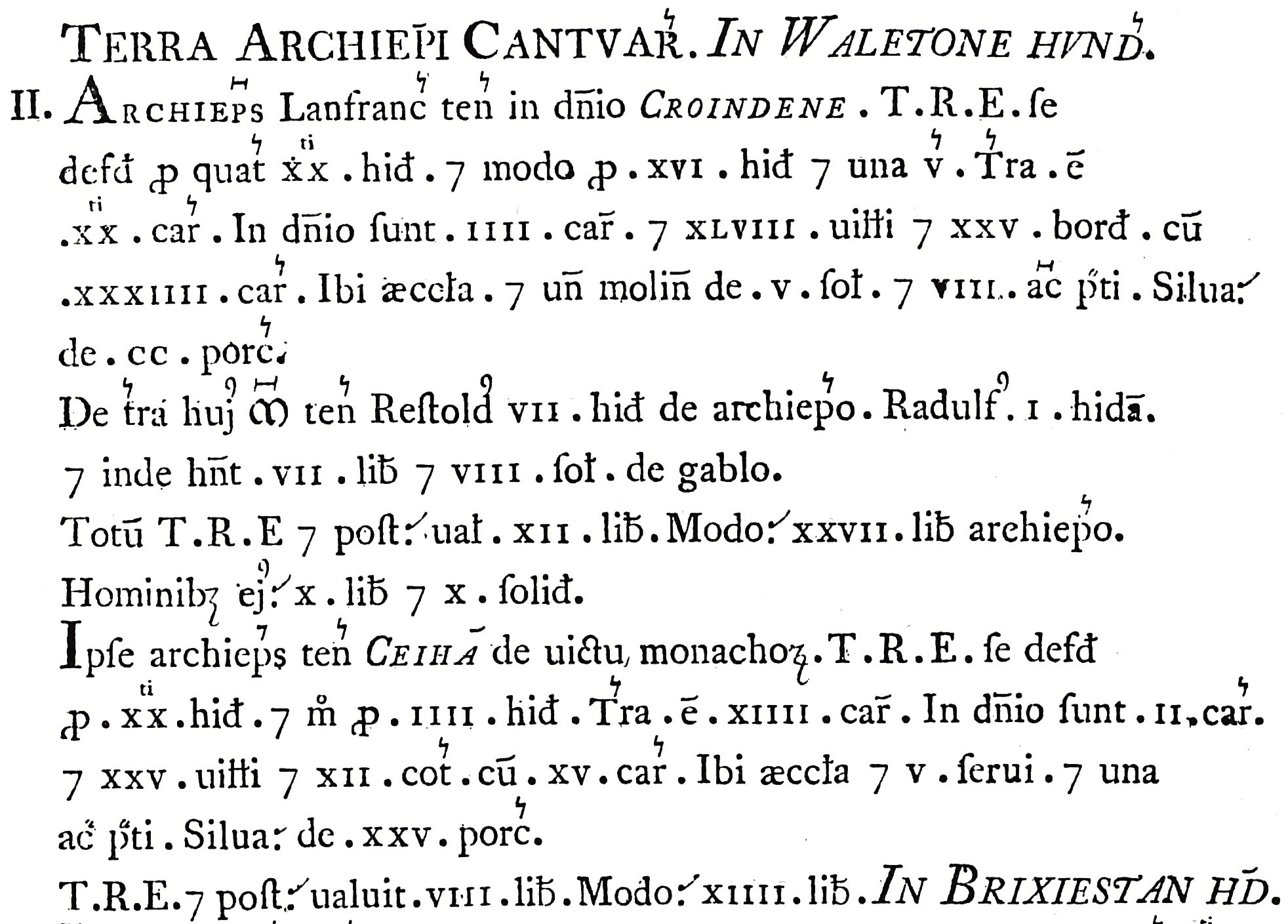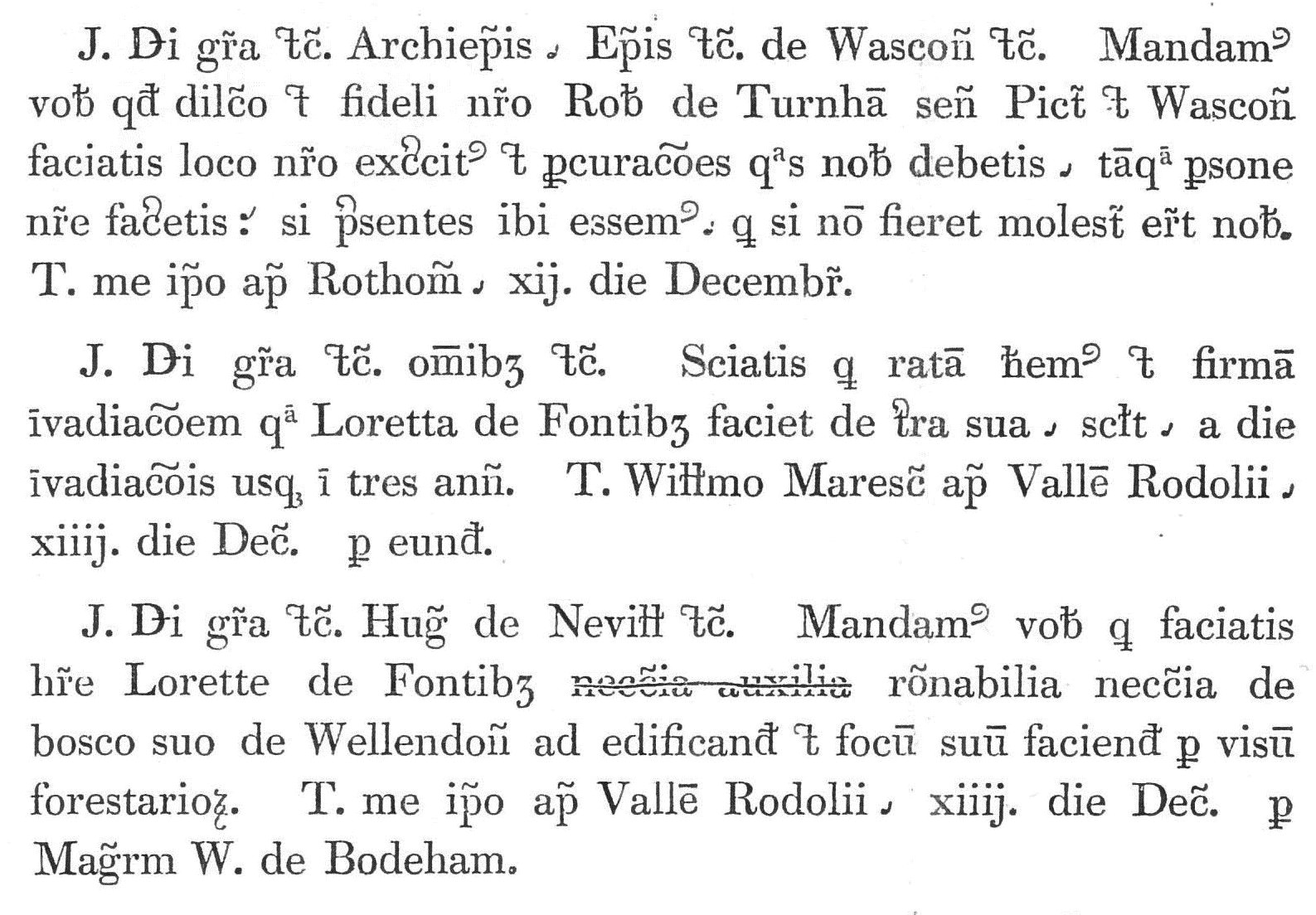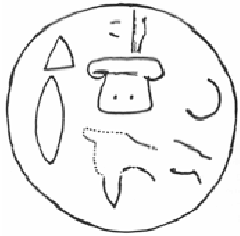|
Record Type
Record type is a family of typefaces designed to allow medieval manuscripts (specifically those from England) to be published as near-facsimiles of the originals. The typefaces include many special characters intended to replicate the various scribal abbreviations and other unusual glyphs typically found in such manuscripts. They were used in the publication of archival texts between 1774 and 1900. History Record type was originally developed in the 1770s when plans were under way for the publication of Domesday Book. Early experiments in using special typefaces were not successful, but in 1773 the printer John Nichols designed a record type for an extract from Domesday to be included in John Hutchins' ''History and Antiquities of the County of Dorset'' (published in 1774). He was so pleased with the result that he and the co-editor of Domesday, Abraham Farley, persuaded the Treasury that the typeface should be adopted for the main Domesday project. It was consequently used ... [...More Info...] [...Related Items...] OR: [Wikipedia] [Google] [Baidu] |
Domesday Croydon Cheam
Domesday Book () – the Middle English spelling of "Doomsday Book" – is a manuscript record of the "Great Survey" of much of England and parts of Wales completed in 1086 by order of King William I, known as William the Conqueror. The manuscript was originally known by the Latin name ''Liber de Wintonia'', meaning "Book of Winchester", where it was originally kept in the royal treasury. The ''Anglo-Saxon Chronicle'' states that in 1085 the king sent his agents to survey every shire in England, to list his holdings and dues owed to him. Written in Medieval Latin, it was Scribal abbreviation, highly abbreviated and included some vernacular native terms without Latin equivalents. The survey's main purpose was to record the annual value of every piece of landed property to its lord, and the resources in land, manpower, and livestock from which the value derived. The name "Domesday Book" came into use in the 12th century. Richard FitzNeal wrote in the ''Dialogus de Scaccario'' ( ... [...More Info...] [...Related Items...] OR: [Wikipedia] [Google] [Baidu] |
Record Commission
The Record Commissions were a series of six Royal Commissions of Great Britain and (from 1801) the United Kingdom which sat between 1800 and 1837 to inquire into the custody and public accessibility of the state archives. The Commissioners' work paved the way for the establishment of the Public Record Office in 1838. The Commissioners were also responsible for publishing various historical records, including the '' Statutes of the Realm'' (i.e. of England and Great Britain) to 1714 and the ''Acts of Parliament of Scotland'' to 1707, as well as a number of important medieval records. Although the six Commissions were technically distinct from one another, there was a considerable degree of continuity between them, and it is common practice to regard them as a single entity and to refer to them in singular form as the Record Commission. Activities The first Commission was established on 19 July 1800, on the recommendation of a Select committee appointed earlier in the year, on th ... [...More Info...] [...Related Items...] OR: [Wikipedia] [Google] [Baidu] |
Serif Typefaces
This is a list of typefaces, which are separated into groups by distinct artistic differences. The list includes typefaces that have articles or that are referenced. Superfamilies that fall under more than one category have an asterisk (*) after their name. Serif * Adobe Jenson *Albertus * Aldus *Alexandria * Algerian * Amelia (Designed in 1963 by Stan Davis) * American Typewriter * Antiqua *Arno* * Aster *Aurora ** News 706 *Baskerville *Bell (Didone classification serif type designed by Richard Austin, 1788) * Belwe Roman *Bembo * Bernhard Modern *Bodoni **Bauer Bodoni * Bitstream Charter * Bookman * Bulmer * Caledonia * Calisto MT * Cambria * Capitals * Cartier *Caslon ** Wyld * Caslon Antique / Fifteenth Century * Centaur * Century type family * Charis SIL * Cheltenham * Clearface *Cochin *Computer Modern *Concrete Roman * Constantia * Copperplate Gothic * DejaVu Serif * Didot *Droid Serif * Emerson * Fairfield * Fat face *FF Scala * Fixedsys * Footlight * Friz Quadrata * Gar ... [...More Info...] [...Related Items...] OR: [Wikipedia] [Google] [Baidu] |
Typefaces And Fonts Introduced In 1774
A typeface (or font family) is the design of lettering that can include variations in size, weight (e.g. bold), slope (e.g. italic), width (e.g. condensed), and so on. Each of these variations of the typeface is a font. There are thousands of different typefaces in existence, with new ones being developed constantly. The art and craft of designing typefaces is called ''type design''. Designers of typefaces are called ''type designers'' and are often employed by ''type foundries''. In desktop publishing, type designers are sometimes also called ''font developers'' or ''font designers''. Every typeface is a collection of glyphs, each of which represents an individual letter, number, punctuation mark, or other symbol. The same glyph may be used for characters from different scripts, e.g. Roman uppercase A looks the same as Cyrillic uppercase А and Greek uppercase alpha. There are typefaces tailored for special applications, such as cartography, astrology or mathematics. Term ... [...More Info...] [...Related Items...] OR: [Wikipedia] [Google] [Baidu] |
Palaeography
Palaeography (American and British English spelling differences#ae and oe, UK) or paleography (American and British English spelling differences#ae and oe, US; ultimately from grc-gre, , ''palaiós'', "old", and , ''gráphein'', "to write") is the study of historic writing systems and the deciphering and dating of historical manuscripts, including the analysis of historic handwriting. It is concerned with the forms and processes of writing; not the textual content of documents. Included in the discipline is the practice of deciphering, reading, and dating manuscripts, and the cultural context of writing, including the methods with which writing and books were produced, and the history of Scriptorium, scriptoria. The discipline is one of the auxiliary sciences of history. It is important for understanding, authenticating, and dating historic texts. However, it generally cannot be used to pinpoint dates with high precision. Application Palaeography can be an essential skill ... [...More Info...] [...Related Items...] OR: [Wikipedia] [Google] [Baidu] |
Academic Publishing
Academic publishing is the subfield of publishing which distributes academic research and scholarship. Most academic work is published in academic journal articles, books or theses. The part of academic written output that is not formally published but merely printed up or posted on the Internet is often called "grey literature". Most scientific and scholarly journals, and many academic and scholarly books, though not all, are based on some form of peer review or editorial refereeing to qualify texts for publication. Peer review quality and selectivity standards vary greatly from journal to journal, publisher to publisher, and field to field. Most established academic disciplines have their own journals and other outlets for publication, although many academic journals are somewhat interdisciplinary, and publish work from several distinct fields or subfields. There is also a tendency for existing journals to divide into specialized sections as the field itself becomes more spec ... [...More Info...] [...Related Items...] OR: [Wikipedia] [Google] [Baidu] |
Typography
Typography is the art and technique of arranging type to make written language legible, readable and appealing when displayed. The arrangement of type involves selecting typefaces, point sizes, line lengths, line-spacing ( leading), and letter-spacing (tracking), as well as adjusting the space between pairs of letters (kerning). The term ''typography'' is also applied to the style, arrangement, and appearance of the letters, numbers, and symbols created by the process. Type design is a closely related craft, sometimes considered part of typography; most typographers do not design typefaces, and some type designers do not consider themselves typographers. Typography also may be used as an ornamental and decorative device, unrelated to the communication of information. Typography is the work of typesetters (also known as compositors), typographers, graphic designers, art directors, manga artists, comic book artists, and, now, anyone who arranges words, letters, numbers ... [...More Info...] [...Related Items...] OR: [Wikipedia] [Google] [Baidu] |
Medieval Unicode Font Initiative
In digital typography, the Medieval Unicode Font Initiative (MUFI) is a project which aims to coordinate the encoding and display of special characters in medieval texts written in the Latin alphabet, which are not encoded as part of Unicode. Organization MUFI was founded in July 2001 by a workgroup consisting of Odd Einar Haugen (Bergen), Alec McAllister (Leeds), and Tarrin Wills (Sydney). From 2006 to 2015, MUFI had a board of four members, consisting of the three founding members and Andreas Stötzner (Leipzig). Currently the board consists of Tarrin Wills, Copenhagen (Chair), Alex Speed Kjeldsen, Copenhagen (Deputy chair), Odd Einar Haugen, Bergen and Beeke Stegmann, Iceland. Character variants In medieval texts, many special ligatures, scribal abbreviations, and letter forms existed, which are no longer a part of the Latin alphabet. As few of these characters are encoded in Unicode, ligatures have to be broken up into separate letters when digitized. Since few fonts sup ... [...More Info...] [...Related Items...] OR: [Wikipedia] [Google] [Baidu] |
Palaeography
Palaeography (American and British English spelling differences#ae and oe, UK) or paleography (American and British English spelling differences#ae and oe, US; ultimately from grc-gre, , ''palaiós'', "old", and , ''gráphein'', "to write") is the study of historic writing systems and the deciphering and dating of historical manuscripts, including the analysis of historic handwriting. It is concerned with the forms and processes of writing; not the textual content of documents. Included in the discipline is the practice of deciphering, reading, and dating manuscripts, and the cultural context of writing, including the methods with which writing and books were produced, and the history of Scriptorium, scriptoria. The discipline is one of the auxiliary sciences of history. It is important for understanding, authenticating, and dating historic texts. However, it generally cannot be used to pinpoint dates with high precision. Application Palaeography can be an essential skill ... [...More Info...] [...Related Items...] OR: [Wikipedia] [Google] [Baidu] |
Photozincography
Photozincography, sometimes referred to as heliozincography but essentially the same process, known commercially as zinco, is the photographic process developed by Sir Henry James FRS (1803–1877) in the mid-nineteenth century. This method enabled the accurate reproduction of images, manuscript text and outline engravings, which proved invaluable when originally used to create maps during the Ordnance Survey of Great Britain during the 1850s, carried out by the government's Topographical Department, headed by Colonel Sir Henry James. Basis The foundation of this method is the insolubility of bichromate of potash upon exposure to light, allowing the printing of images on to zinc from photographic negatives. Method At this time, high-contrast negatives were made using the wet plate collodion method (a solution of nitrocellulose in ether or acetone on glass). Once the negative had been made, a sheet of thin tracing paper was coated in a mixture of saturated potassium bichroma ... [...More Info...] [...Related Items...] OR: [Wikipedia] [Google] [Baidu] |
Frederic William Maitland
Frederic William Maitland (28 May 1850 – ) was an English historian and lawyer who is regarded as the modern father of English legal history. Early life and education, 1850–72 Frederic William Maitland was born at 53 Guilford Street, London, in 1850, the only son and second of three children of John Gorham Maitland and of Emma, daughter of John Frederic Daniell. His grandfather was Samuel Roffey Maitland. Maitland's father was a barrister but, having little practice, became a civil servant, serving as secretary to the Civil Service Commission. Maitland was educated at a preparatory school in Brighton before entering Eton College in 1863, where Edward Daniel Stone was his private tutor. At Eton, Maitland was not prominent either academically or athletically, although a close school friend thought he would become "a kind of philosophic Charles Lamb". He then matriculated at Trinity College, Cambridge, in 1869 as a commoner. A dislike of classics acquired at Eton initially ... [...More Info...] [...Related Items...] OR: [Wikipedia] [Google] [Baidu] |
Selden Society
The Selden Society is a learned society and registered charity concerned with the study of English legal history. It functions primarily as a text publication society, but also undertakes other activities to promote scholarship within its sphere of interest. It is the only learned society wholly devoted to the topic of English legal history. The society takes its name from the eminent English jurist and legal and constitutional scholar, John Selden (1584–1654). History and activities The society was founded in 1887 by a group which included F. W. Maitland, who served as its first literary editor and personally edited eight volumes for the Society. The Society's first years were rocky: its treasurer, P. E. Dove, committed suicide in 1894, leaving behind a deficit of £1,000. Its principal activity is publishing historical records of English law. Since its inception, a volume of significant texts has been published every year. It also publishes a supplementary series. The cu ... [...More Info...] [...Related Items...] OR: [Wikipedia] [Google] [Baidu] |






